Walk-in shower ideas – 14 ways to embrace a spa-like space at home
Wondering whether a walk-in shower will work for you? We’ve got walk-in shower inspiration for bathrooms large and small

- 1. Mix materials
- 2. Create flow with continuous flooring
- 3. Stick to a shower curtain
- 4. Drench the room in colour
- 5. Tank the floors
- 6. Squeeze a shower into a corner
- 7. Don’t sacrifice the bath
- 8. Invest in a designer screen
- 9. Build in storage
- 10. Turn it on without getting soaked
- 11. Install a skylight
- 12. Step it up
- 13. Protect your modesty
- 14. Choose sleek, seamless walls
- FAQs

Holly Cockburn
Walk-in shower ideas are having a major moment for a very good reason. Halfway between a fully enclosed shower and a wet room, they offer the best of both worlds in terms of style and practicality. You get to enjoy the spaciousness of a wet room while keeping the rest of room splash-free.
One of the simplest ways to install a walk-in shower idea is to buy a specialist walk-in enclosure, complete with low-level tray and screens on one or more sides, depending on whether it is to be installed in a corner, alcove or centrally on a wall. The entrance will always be open, but you won’t need to worry about tanking or draining gradients to ensure the water flows away properly and the rest of your bathroom stays dry.
Walk-in shower ideas
The great news is that walk-in showers, unlike with wet room ideas, can work brilliantly no matter what size your bathroom. In fact, a walk-in shower ideas can prove an effective space-saving solution, so it's worth discovering how to make one work in your space.
1. Mix materials
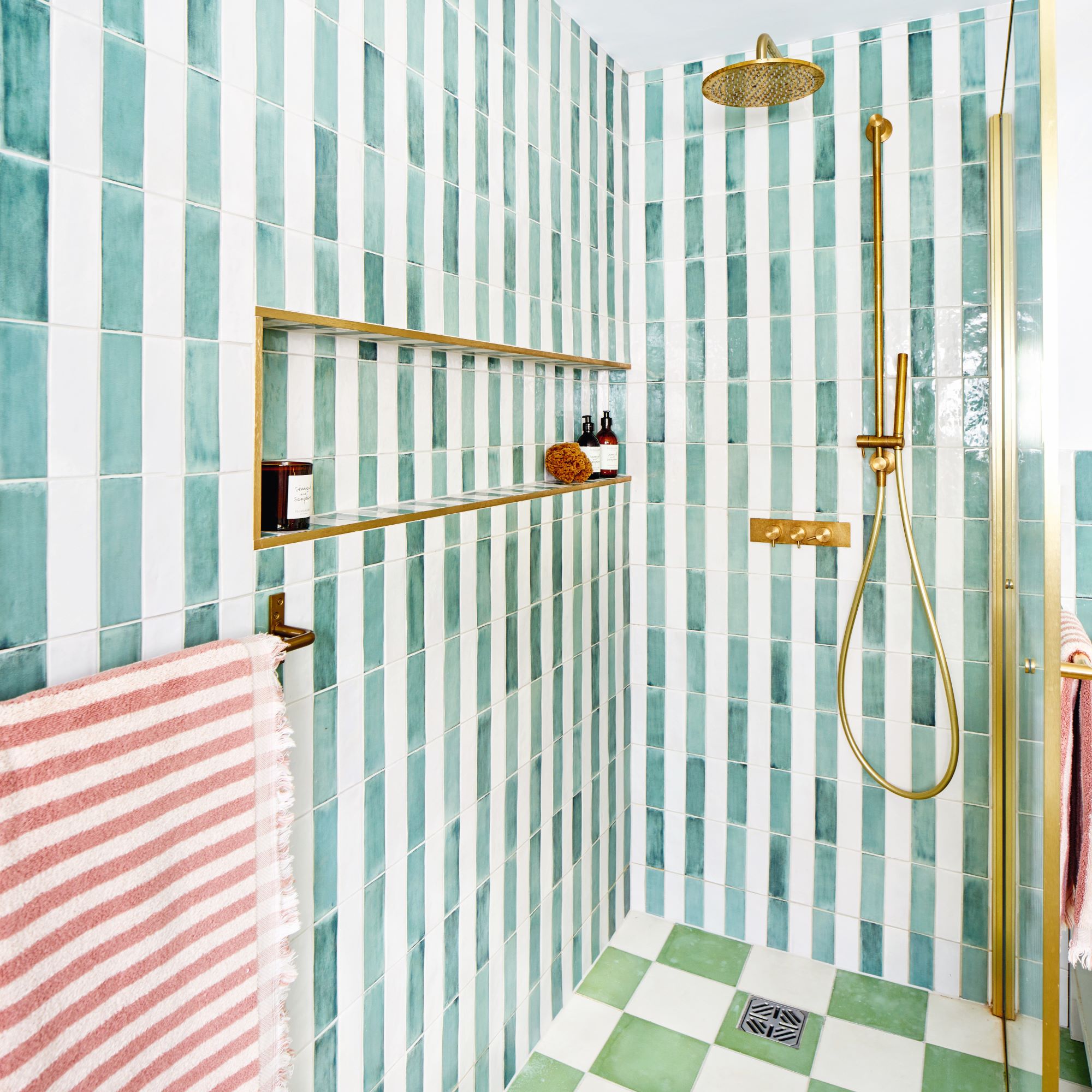
Make the walk-in shower the focus of your bathroom by opting for a combination of wall and floor tiles, instead of keeping to uniform tiles throughout. Try bathroom tile ideas in two contrasting colours or mix patterned tiles with plain to add visual interest and variation.
For an eye-catching effect, combine tiles in different shapes and size formats, but keep to a similar colour palette to create a more harmonious look. Team patterned hexagonal tiles on the main shower wall and floor with neutral or stone-effect tiles on adjoining walls. This will keep the colour palette consistent and create a visual connection without looking overly busy.
2. Create flow with continuous flooring
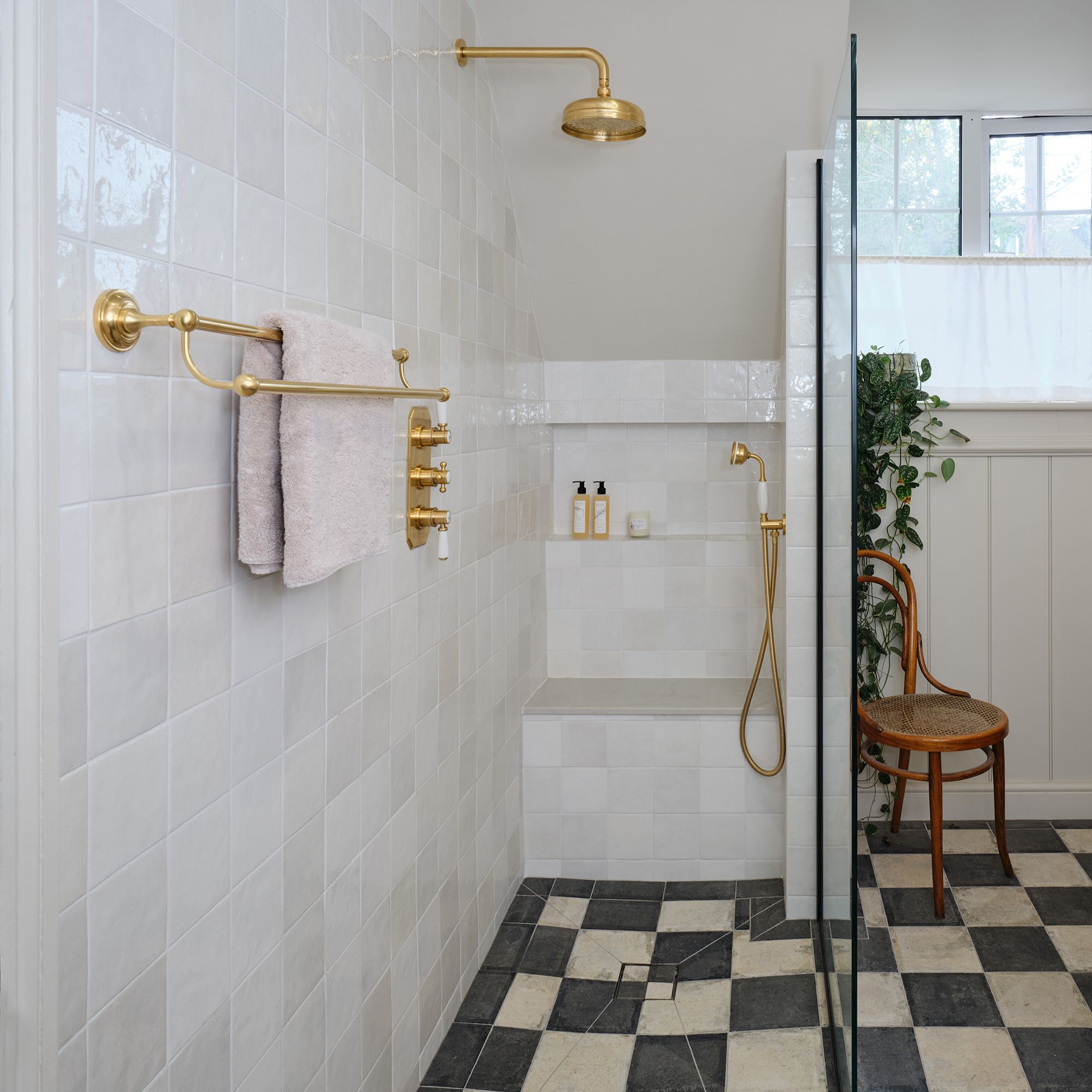
In a compact bathroom, a walk-in shower with access at one end can be an efficient use of space that will still let you manoeuvre easily around the bathroom.
Rather than using a combination of floor tiles or a walk-in shower tray in a small bathroom, opt for the same bathroom flooring ideas throughout to create a more continuous flow. Keeping floor tiling consistent in a small space will trick the eye into thinking that the floor is bigger than it actually is - and the more floor on show, the more spacious the bathroom will feel.
Sign up to our newsletter for style inspiration, real homes, project and garden advice and shopping know-how
3. Stick to a shower curtain
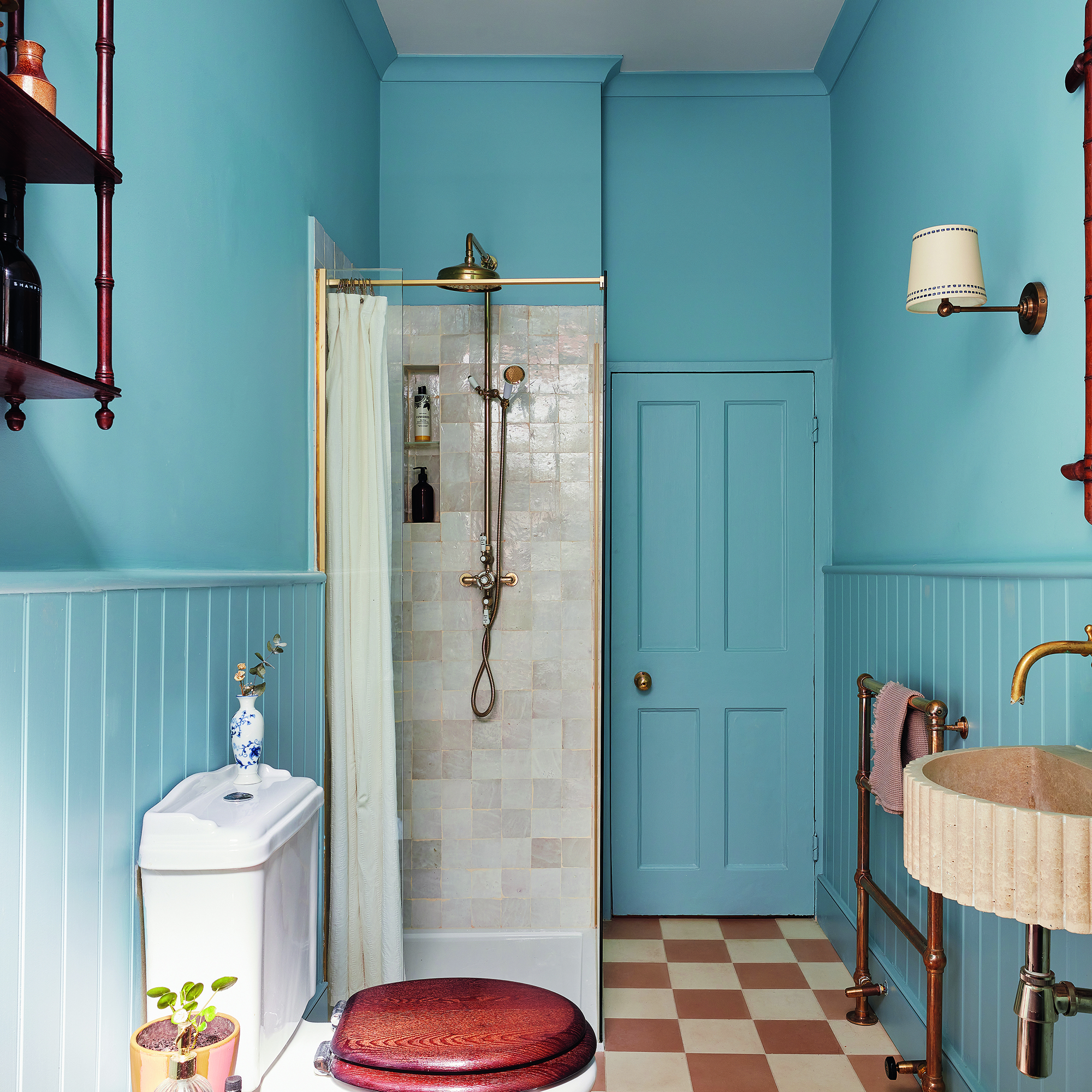
A walk-in shower doesn't have to include a glass door. While shower curtains are most commonly used on baths, you can also add one to a freestanding shower.
If you want to create a more traditional or homely bathroom then large panels of glass might not create the look you're aiming for. Instead, a shower curtain will offer a softer approach that you can customise easily to suit your scheme. Cosy, Grandma-inspired designs are a big bathroom trend for 2024 so a shower curtain on a walk-in shower will only add to the aesthetic.
4. Drench the room in colour

With all the glossy tiles and hard surfaces on show in a bathroom, there can be a danger of the space feeling quite harsh and clinical. Introducing a bold colour or bathroom tile trend into the equation is a great way around this, adding visual impact and making the bathroom feel warm and tactile.
Cladding the ceiling area with wood is another colour trick that can add warmth and help to enclose the space for a cosy vibe. Use brushed brass or gold shower fittings and fixtures to add a luxurious feel.
5. Tank the floors
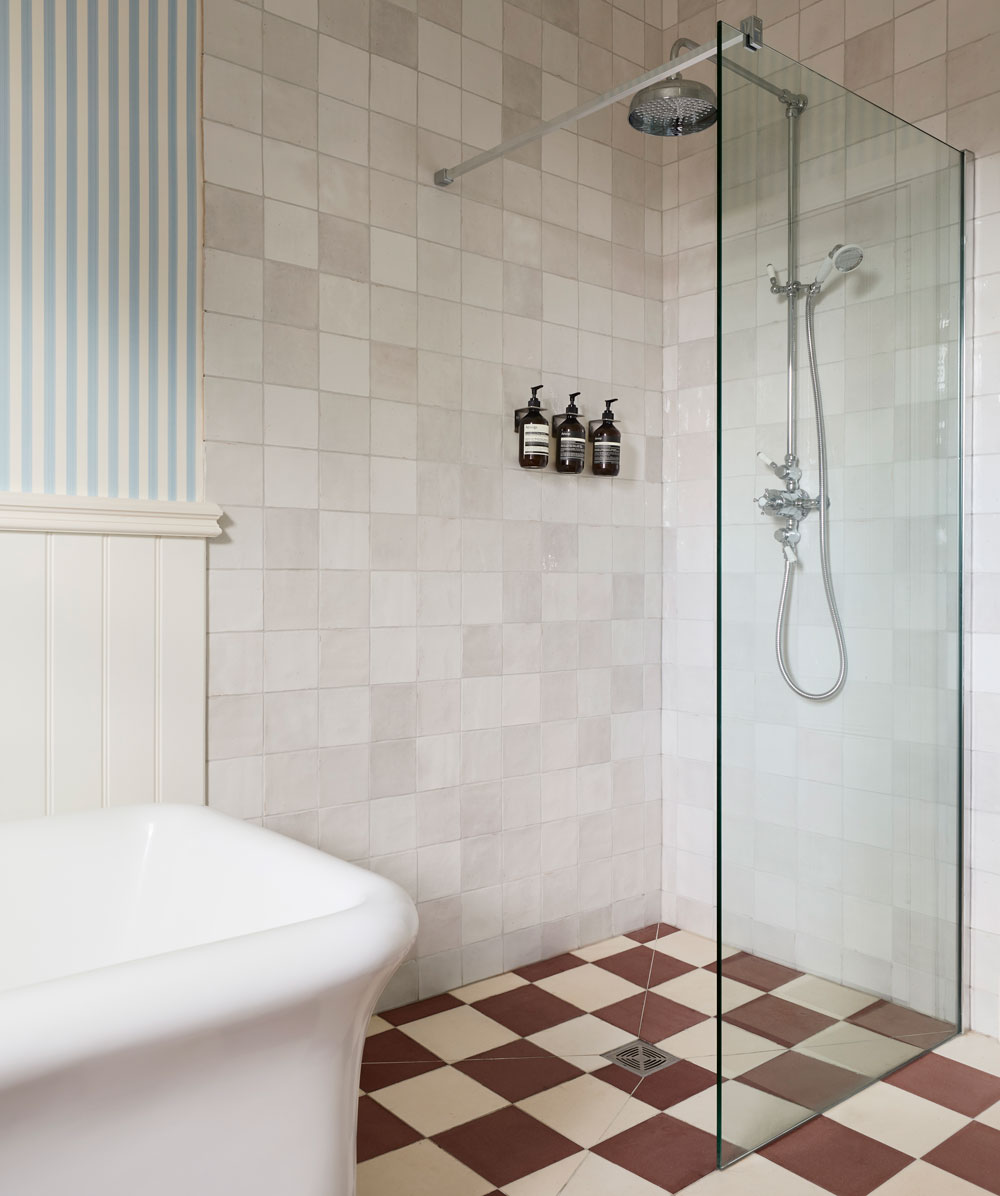
For a wet-room look without the soggy toilet roll, tank the room and install a single glass screen. This walk-in shower idea allows easy, level access, making it a great choice for inclusive use. For minimal visual interruption, choose a frameless screen – sometimes called wet room panels. A wall-mounted support arm is sufficient for small screens like this one. But larger panels should be fixed at floor level for extra rigidity.
‘High-impact floor tiles will help distract attention away from the screen, so you’ll barely notice it’s there,’ adds Barrie Cutchie, design director at BC Designs. ‘Continuing the same floor tiles throughout will also make your walk-in shower feel bigger and less busy.’
6. Squeeze a shower into a corner
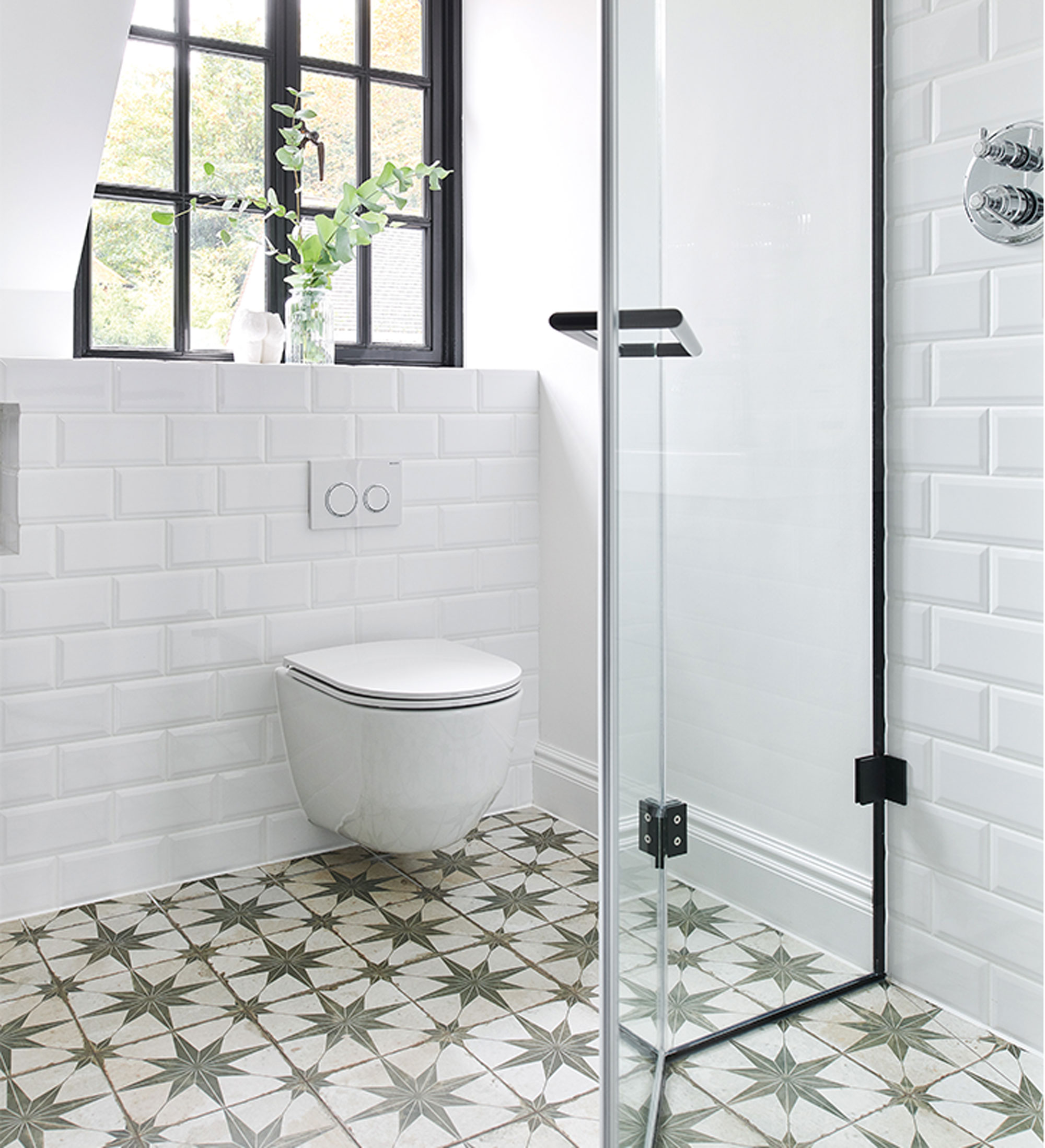
Tight on space? In a small bathroom or confined space opt for a foldaway shower door so that you can still enjoy the luxury of a walk-in shower. A hinged design can be opened out fully while showering - or folded away against the wall when the shower is not in use.
Keep walls, tiling and grout lines all one colour to create the illusion of space in a small bathroom. White or a pale, light-reflective shade will bounce light around the room to maximise natural daylight. Confine pattern to the floor area, opting for the same design throughout, which can help to visually widen the space and make a small bathroom feel less cramped.
7. Don’t sacrifice the bath

If you really can’t do without a tub, then be savvy with your space and tweak the dimensions so you can include a walk-in shower with your shower bath ideas. Most standard-sized baths measure up to 1700mm in length, but by forgoing a full-length model and opting for a more compact 1500-1400mm bath, there should be space enough to accommodate both.
Try a side-by-side layout that will use up less of the bathroom footprint than having bath and shower set apart. It will also leave more space for the basin and loo to be positioned on an opposite wall. Opt for a glass screen to separate the bath and shower, which will keep the bathroom feeling bright and airy and also help to prevent splashes from escaping too.
8. Invest in a designer screen
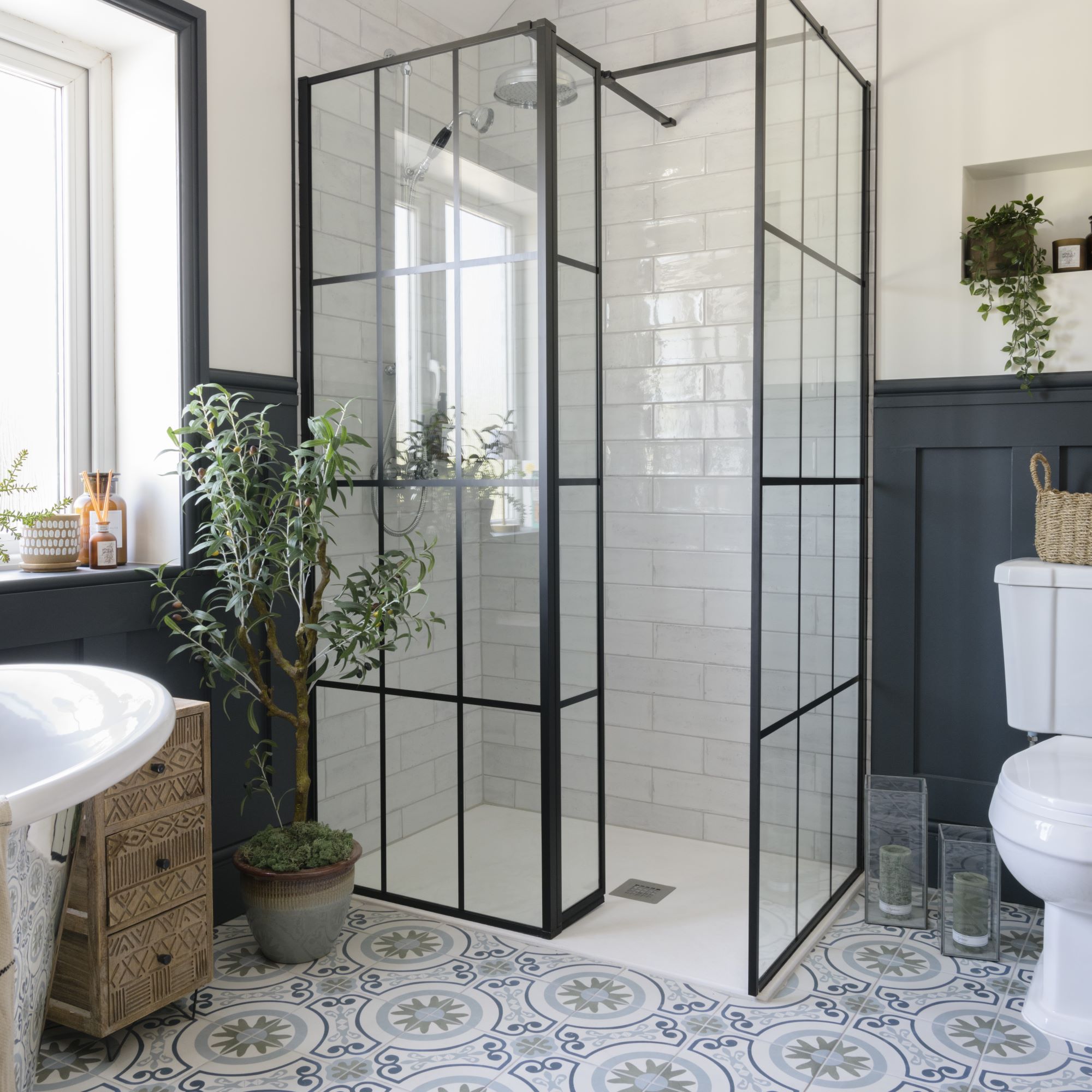
Walk-in showers are pretty unobtrusive compared to full enclosures but that needn’t equal boring. Crittall-style screens, which mimic the metal framing of Crittall glazing are now widely available, and more affordable. ‘Matt black is so on-trend in bathrooms just now. We love incorporating Crittall-style screens into our designs to achieve that striking, urban-chic look,’ enthuses bathroom designer Rosie Proto, from Pier1 Bathrooms.
‘The Merlyn screens we use have the black coating fully integrated into the underlying aluminium substrate, so it cannot chip or peel, making it really durable. It’s the perfect screen for a minimalist yet impactful walk-in shower.’
9. Build in storage
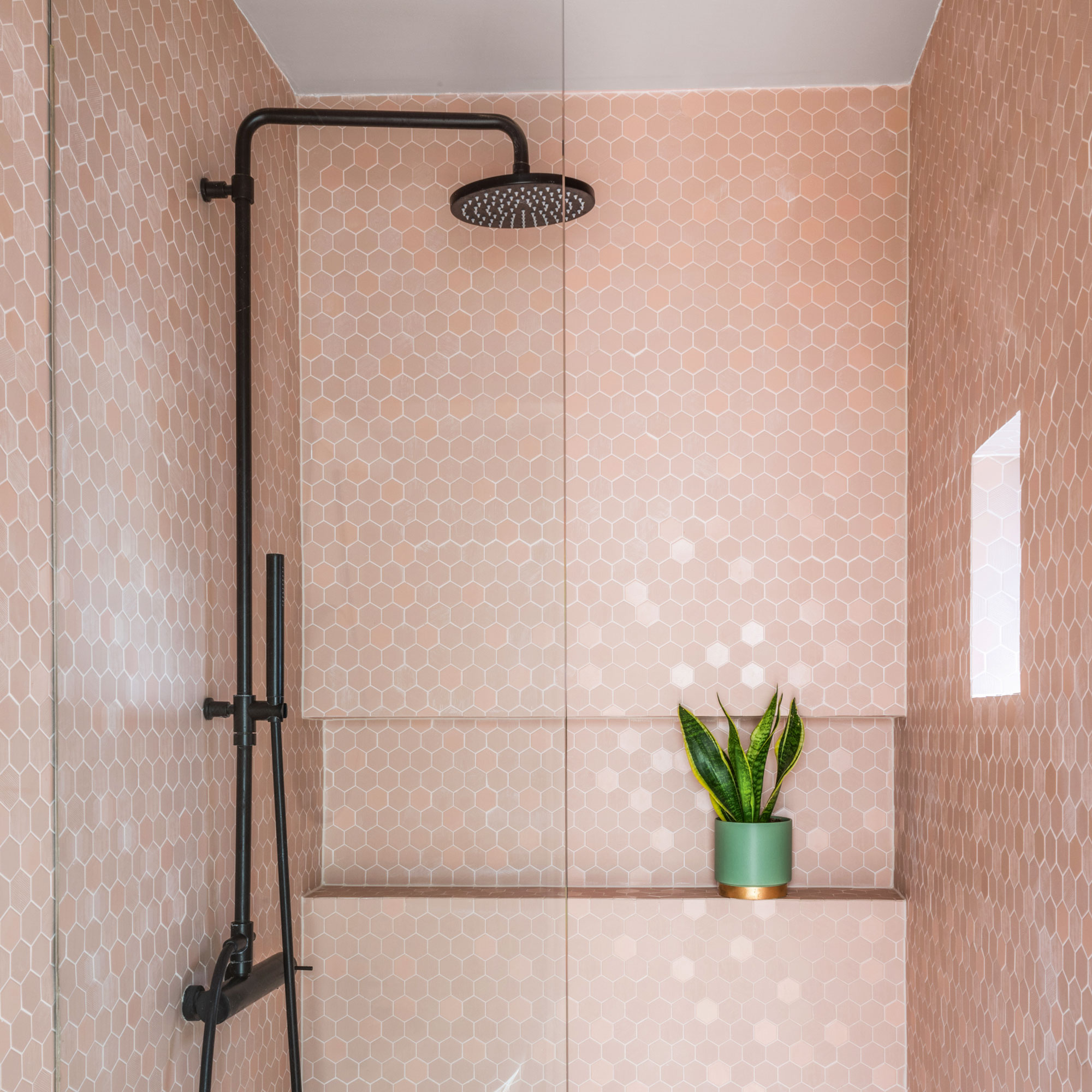
Storing shampoo and soap within arm’s reach is key to showering comfort, not to mention a clutter-free bathroom! If you’re building out stud walls to accommodate a new walk-in shower, adding in smart shower storage ideas like niches makes the best use of the empty void behind the tiles. It also looks far slicker than protruding shelves, and you won’t bash your elbows on them while lathering up!
There are two important points to remember when building in storage. First, don’t position your storage niches directly under the shower head, otherwise your toiletries will be forever sat in a pool of water.
Secondly, make sure you tile the shelf on a very slight gradient to encourage any water to drain away. For extra spa appeal, include waterproof downlights inside the niches and enjoy atmospheric lighting by night.
10. Turn it on without getting soaked
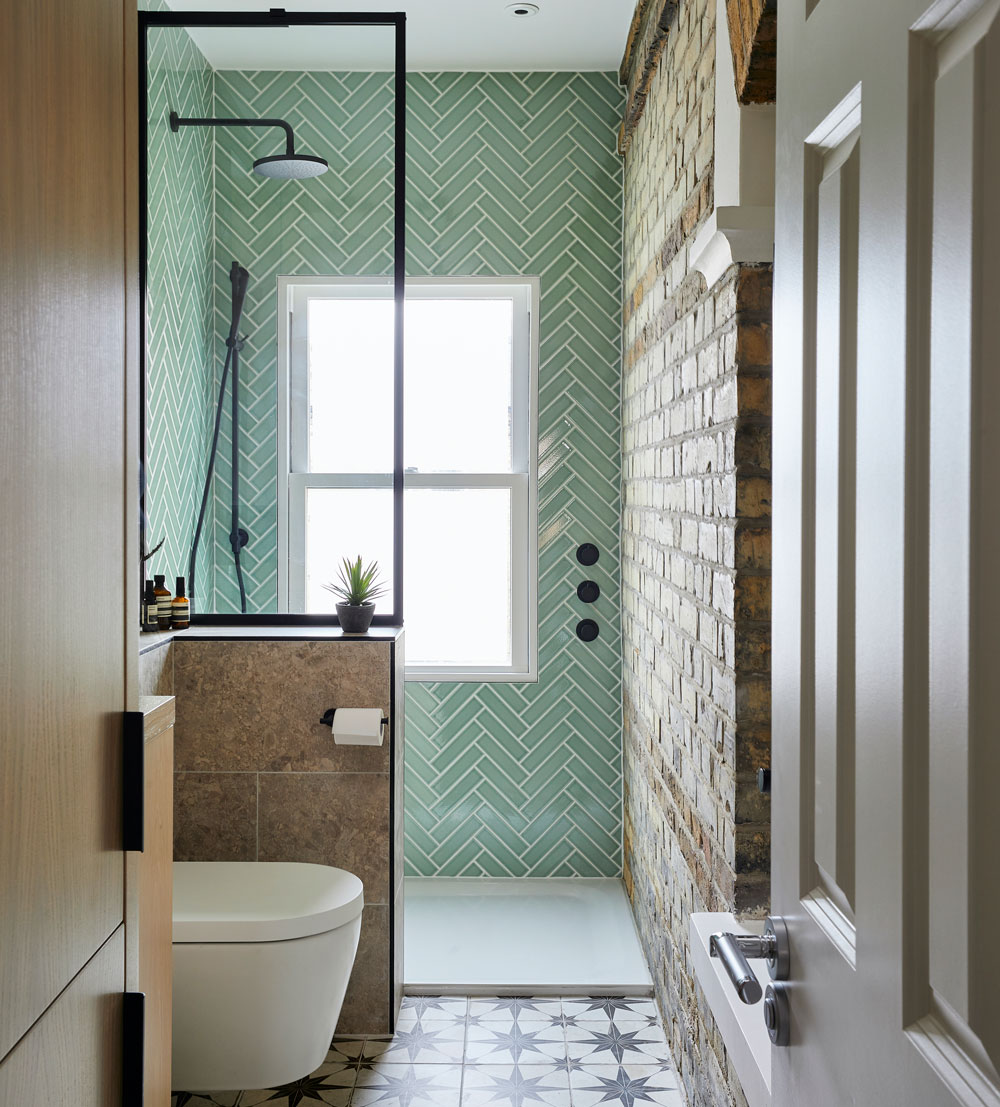
Walk-in showers generally have the shower head located furthest away from the entrance to keep the rest of the bathroom dry. This bathroom layout idea can make it harder to lean in and turn the controls on, than in a corner enclosure or over-bath shower for example.
Luckily the solution is simple, as Huntsmore’s director Eamonn Agha explains. ‘When designing a walk-in shower, we would ideally have the shower mixer controls at the entrance so that you can turn on the shower and adjust the heating to get the perfect temperature before entering.
‘It also means you can turn the shower on whilst fully dressed and not get cold or wet if trying to reach for the controls under the showerhead.’
11. Install a skylight
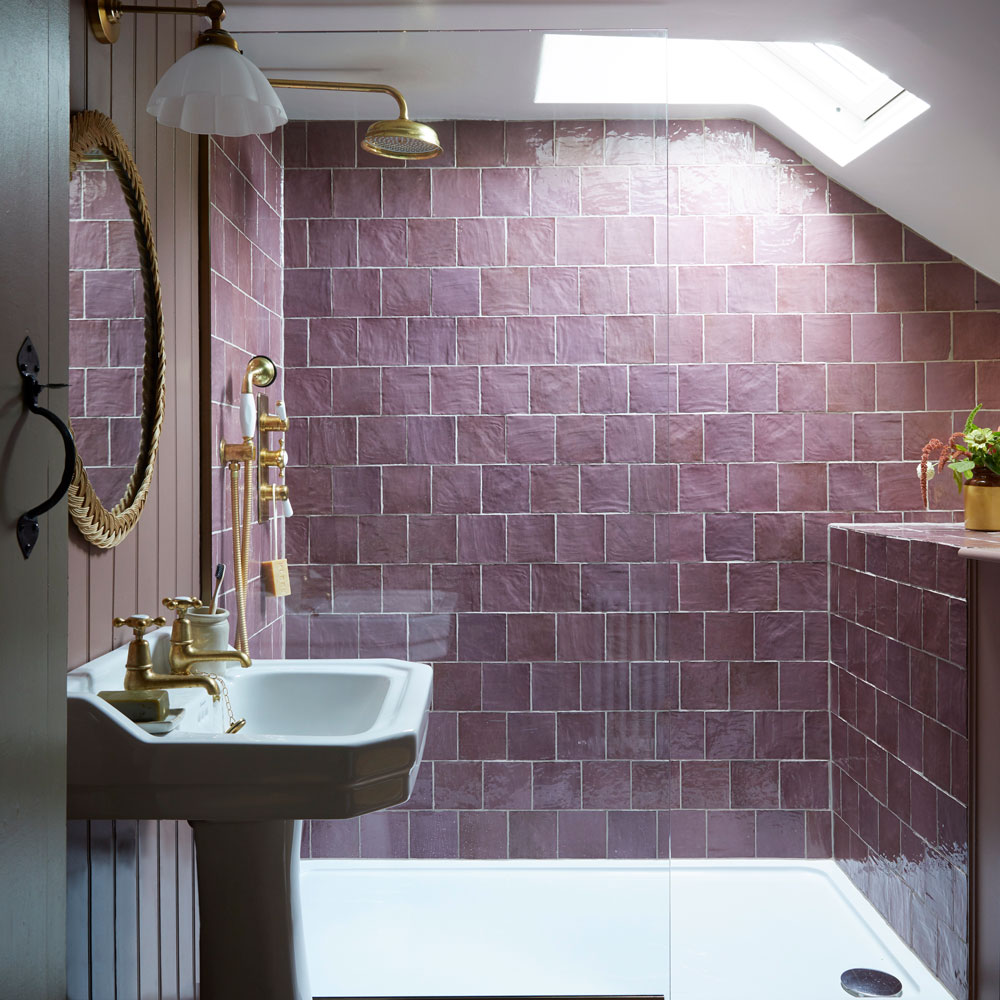
Adding windows in the roof can transform a dark or dingy walk-in shower room. Particularly in the mornings when a blast of Vitamin D will help kick-start your day.
While perfect for loft conversions, skylights can also be used to brighten up any bathroom with no void between ceiling and roof, such as extensions with flat roofs and mansard rooms. In this cosy walk-in shower room, interior designer Laura Stephens has used glossy tiles to help reflect light from the above around the space.
Do invest in self-cleaning glass, especially if your skylight is hard to access from outside. Go as big as you can manage and position the skylight directly inside the showering area for maximum invigoration.
12. Step it up

Not every room is suited to a level-entry walk-in shower installation, especially if there isn’t sufficient plumbing space in the floor joists. This is a common scenario in period country homes and loft conversions but don’t despair; raising the shower tray has a number of advantages. Firstly, all those pipes can be easily stashed and the correct drainage gradients achieved with minimal disruption.
Secondly, a raised level will make it far easier to keep the rest of the bathroom floor dry, helping to prevent slip hazards in the process. We love the raised-level walk-in shower in this modern bathroom idea. Extending the width of the floor area inside the shower with colourful tiles increases the sense of space inside.
13. Protect your modesty

Not only is reeded glass fashion-forward but its softly defused surface will bring an element of modesty to your walk-in showering environment. Perfect for providing privacy in shared en-suite bathroom designs, a simple reeded glass panel is all you need for uninhibited showering.
Install the glass with the reeded texture on the exterior to achieve a smooth easy-to-clean surface inside the shower. The external rail on this smart screen is ideal for keeping your towel close to hand.
14. Choose sleek, seamless walls
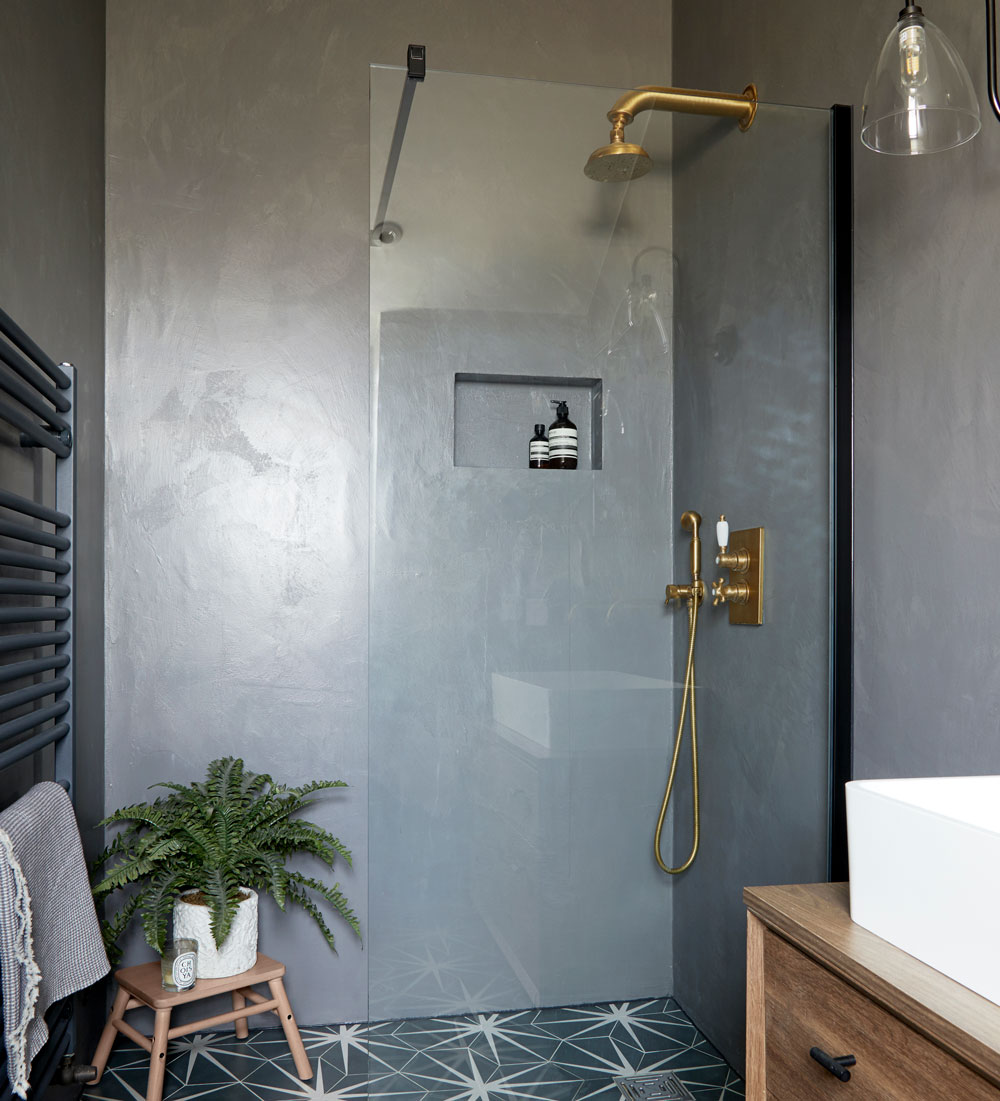
The space inside your walk-in shower needs to be waterproof but tiling from floor-to-ceiling can feel cold, plus grout cleaning is never fun! Microcement, a.k.a. polished plaster, is an on-trend alternative to tiles – providing a sleek, seamless backdrop to any walk-in shower.
‘Microcement is essentially a waterproof plaster that is built up in layers to create an easy-clean, non-porous surface,’ says interior designer Fiona Duke.
‘Pigments can be added to create whatever colour you like, and it has a subtly textured surface that adds a tactile dimension. In a smaller walk-in shower the lack of grout lines keeps the vertical surfaces simpler and enhances the sense of space.’
FAQs
Can you have a walk-in shower in a small bathroom?
Lack of space needn’t be an issue when it comes to installing a walk-in shower in a small bathroom. Opt for a compact shower tray that will take up less floor space, or choose a reduced-depth shower tray that can be installed at a lower level to give step-free access.
Alternatively, consider turning the bathroom into a wet room, where you’ll need a slightly smaller showering area, although the bathroom will require tanking (waterproofing). A frameless glass shower panel or screen won’t block the sightlight, creating the illusion of extra space, while still protecting the rest of the bathroom from splashes.
Is a walk-in shower a good idea?
‘Walk-in Showers not only look good, but are also the ultimate in inclusively designed bathrooms,’ says David Osborne, CEO of Roman Showers.
'Whilst looking stylish, modern and on-trend, users of all ages and abilities find them easy to use and access – the lack of handles or mechanisms (and often steps or thresholds) makes them particularly appealing to those with arthritis, yet equally chic for younger generations.’
How practical is a walk-in shower?
It depends on whether the room is fully tanked, and you’re just using the screen to keep the loo seat dry, or whether you need to contain your shower inside the tray. Therefore, you need the size of space to have available to work with the walk-in shower ideas you're dreaming of.
‘For walk-in showers where you want to keep the rest of the bathroom dry, we always advise you to allow around 50cm for the entranceway width. And from 50-60cm for the showering area,' says David from Roman Showers. 'Therefore, for an effective and comfortable walk-in shower, you should aim for an overall length of about 100-120cm’. Average walk-in shower widths range from 70-100cm.
‘If space is a little tight or you’re worried about keeping water contained, look out for wetroom panels and walk-in enclosures with small pivoting deflector panels that fold out to restrict spray when showering and then fold neatly back when you need to exit.'
Do you prefer a long soak in the bath or is a speedy shower just what you need in your busy life? These walk-in shower ideas will be the perfect antidote no matter your preference.

Linda Clayton is a professionally trained journalist, and has specialised in product design, interiors and fitness for more than two decades. Linda has written for a wide range of publications, from the Daily Telegraph and Guardian to Homes & Gardens and Livingetc. She has been freelancing for Ideal Home Magazine since 2008, covering design trends, home makeovers, product reviews and much more.
- Holly CockburnContent Editor